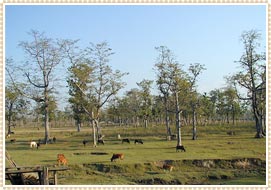
Established
in 1973, the Royal Chitwan National Park is the oldest National Park and
wildlife reserve in Nepal. the Royal Chitwan National Park is located in
the Tarai lowlands of South-Central Nepal. UNESCO designated the park as
a World Heritage Site in the year 1984. The park covers an area of
around 1000 square kilometers and supports a fragile ecosystem. It
contains the Churiya hills, ox-bow lakes and flood plains of Rapti, Reu,
and Narayani Rivers in its circumference.
As far as the flora is concerned, nearly 70% of the Royal Chitwan
National Park vegetation comprises Sal forest. The remaining vegetation
types include grassland (20%) and Pines (5%). The grasslands have a
diverse composition comprising more than 50 species. The Saccharin,
popularly known as elephant grass, can reach as high as 8 meters in
height. The park also supports a very vivid and distinct fauna.
According to a conservative estimate by the UNESCO, the park has at
least 43 species of mammals, over 450 species of birds, and more than 45
species of amphibians and reptiles. Among animals, one-horned
Rhinoceros, Tiger, and Crocodile are given special attention. It is
estimated that the current population of the endangered one-horned Rhino
is around 400. Apart from that, the park also has a sizeable population
of Gaur, Wild Elephant, four-horned Antelope, Striped Hyena, Pangolin,
Gangetic Dolphin, Monitor Lizard, Python, Chital, Hog, Deer, Barking
Deer, Sloth Deer, Common Leopard, Palm Civet and Rhesus Monkeys. A few
of the common birds seen are Peafowl, Red Jungle Fowl, and different
species of egrets, Herons, Kingfishers, Flycatchers and Woodpeckers.
Earlier, the Chitwan Valley was well known for big game hunting and
until 1950 was exclusively managed as a hunting reserve for the Ranas
and their guests. In 1973, His late Majesty King Mahendra approved, in
principle, the creation of Royal Chitwan National Park. One last thing,
Just don't forget to bring a good pair of binoculars and a really good
wide-lens SLR camera.


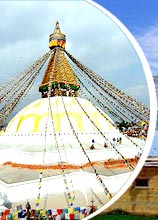
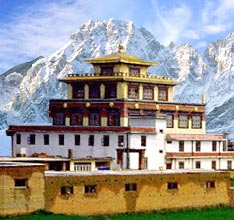
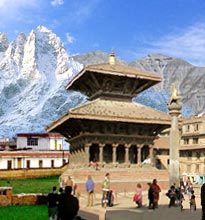
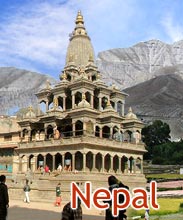
 Established
in 1973, the Royal Chitwan National Park is the oldest National Park and
wildlife reserve in Nepal. the Royal Chitwan National Park is located in
the Tarai lowlands of South-Central Nepal. UNESCO designated the park as
a World Heritage Site in the year 1984. The park covers an area of
around 1000 square kilometers and supports a fragile ecosystem. It
contains the Churiya hills, ox-bow lakes and flood plains of Rapti, Reu,
and Narayani Rivers in its circumference.
Established
in 1973, the Royal Chitwan National Park is the oldest National Park and
wildlife reserve in Nepal. the Royal Chitwan National Park is located in
the Tarai lowlands of South-Central Nepal. UNESCO designated the park as
a World Heritage Site in the year 1984. The park covers an area of
around 1000 square kilometers and supports a fragile ecosystem. It
contains the Churiya hills, ox-bow lakes and flood plains of Rapti, Reu,
and Narayani Rivers in its circumference.  Taj Mahal Tour
Taj Mahal Tour Rajasthan Tours
Rajasthan Tours Kerala Tours
Kerala Tours Kashmir Tours
Kashmir Tours Tamilnadu Tours
Tamilnadu Tours Adventure Tours India
Adventure Tours India Beach Tours India
Beach Tours India Desert Tours India
Desert Tours India Pilgrimage Tours India
Pilgrimage Tours India Ayurveda Tours India
Ayurveda Tours India Buddhist Tours India
Buddhist Tours India Temple
Tours India
Temple
Tours India Sculpture Tours India
Sculpture Tours India Golden Triangle Tour
Golden Triangle Tour India Heritage Tours
India Heritage Tours Hill Tours India
Hill Tours India Honeymoon Tours India
Honeymoon Tours India Kerala Backwaters Tour
Kerala Backwaters Tour India Train Tours
India Train Tours Trekking Tours India
Trekking Tours India India Wildlife Tours
India Wildlife Tours Karnataka Tour
Karnataka Tour Nepal Tour
Nepal Tour Orissa Tour
Orissa Tour Gujarat Tour
Gujarat Tour Andhra Pradesh Tour
Andhra Pradesh Tour Maharashtra Tour
Maharashtra Tour Chardham Tour
Chardham Tour  Golden Chariot
Golden Chariot Himachal Pradesh Tour
Himachal Pradesh Tour Sikkim Tour
Sikkim Tour Madhya Pradesh Tour
Madhya Pradesh Tour